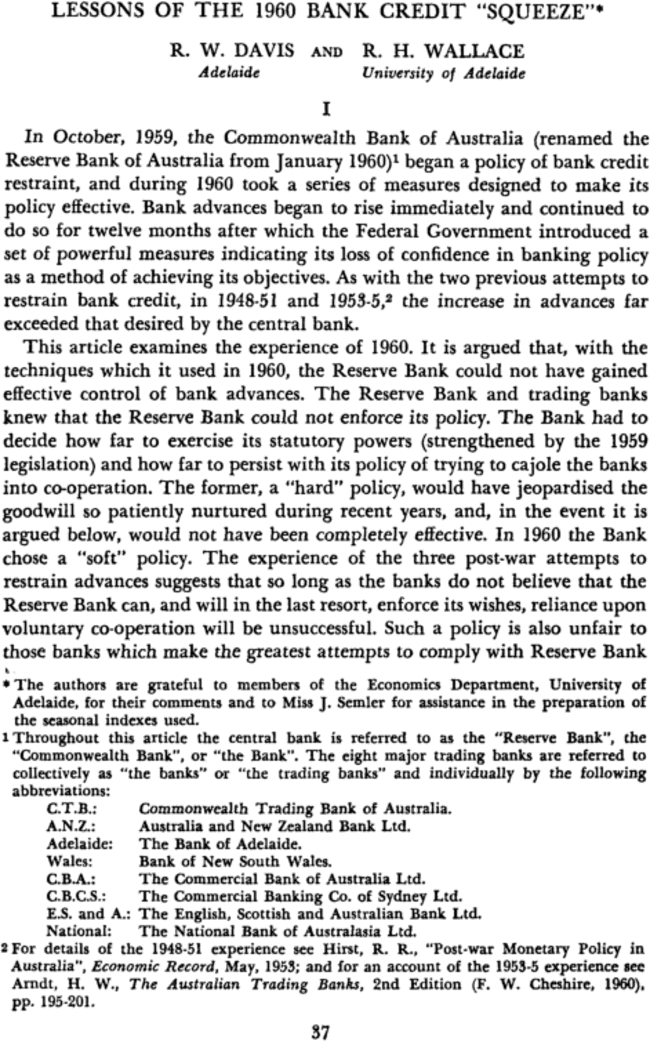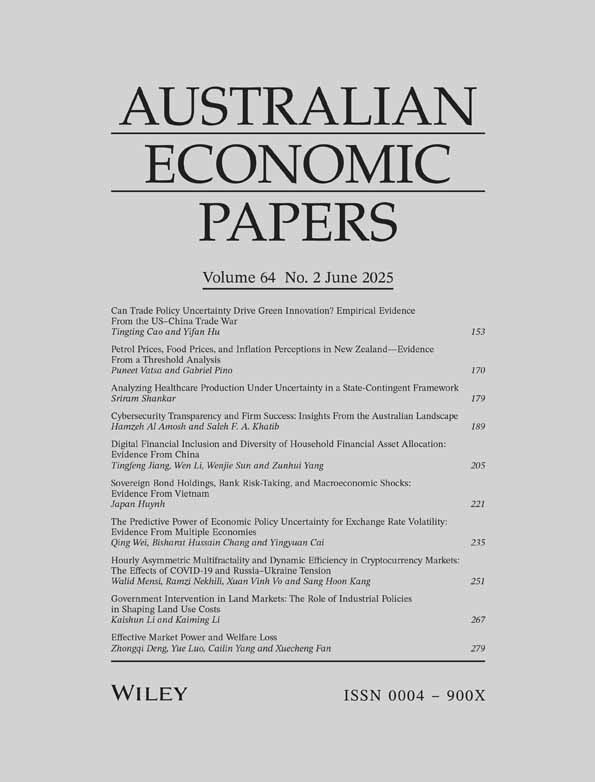Full Access
LESSONS OF THE 1960 BANK CREDIT “SQUEEZE”*
†
*The authors are grateful to members of the Economics Department, University of Adelaide, for their comments and to Miss J. Semler for assistance in the preparation of the seasonal indexes used.

References
- 1 Throughout this article the central bank is referred to as the “Reserve Bank”, the “Commonwealth Bank”, or “the Bank”. The eight major trading banks are referred to collectively as “the banks” or “the trading banks” and individually by the following abbreviations: C.T.B.: Commonwealth Trading Bank of Australia. A.N.Z.: Australia and New Zealand Bank Ltd. Adelaide: The Bank of Adelaide. Wales: Bank of New South Wales. C.B.A.: The Commercial Bank of Australia Ltd. C.B.C.S.: The Commercial Banking Co. of Sydney Ltd. E.S. and A.: The English, Scottish and Australian Bank Ltd. National: The National Bank of Australasia Ltd.
- 2 For details of the 1948–51 experience see Hirst, R. R., “Post-war Monetary Policy in Australia”, Economic Record, May, 1953; and for an account of the 1953–5 experience see Arndt, H. W., The Australian Trading Banks, 2nd Edition (F. W. Cheshire, 1960), pp. 195–201.
- 3 For the earlier attempts to develop a minimum liquidity convention, see Arndt, op. cit., pp. 109–205. Giblin, writing of the period 1935–40, mentions the problems caused by the absence of a liquidity convention, and the difficulties arising out of the startling differences in the degrees of liquidity maintained by different banks. See Giblin, L. F., The Growth of a Central Bank (M.U.P., 1951), pp. 249–50.
- 4 Reserve Bank of Australia, Report and Financial Statements 1962, p. 21.
- 5 It might be thought that M and B would not occur simultaneously in any bank's balance sheet. In fact all the banks which borrowed had, simultaneously, money at call. The National, for example, in August, 1960, was borrowing 9m., and for the same month its lending to the money market was 1·6m. As Reserve Bank loans are for a minimum period of a month a bank which borrowed more than it actually needed to maintain the L.G.S. convention would probably lend the surplus to the money market. However, the amounts involved are so large that it seems unlikely that this factor alone fully explains this apparent anomaly.
- 6 See Arndt, op. cit., pp. 27–30.
- 7 Reserve Bank of Australia, Report and Financial Statements 1960, p. 19.
- 8 Ibid..
- 9 Ibid..
- 10 From the viewpoint of pressure on the banks' excess liquidity a given percentage increase in the L.G.S. ratio is equivalent to the same percentage increase in the S.R.D. ratio. The banks would prefer the former since the earning rate on L.G.S. assets is above that on S.R.D's. However, it is extremely important that the banks should come to regard the minimum L.G.S. ratio as something rigid, to be observed at all times; to foster this it may not be expedient for the Bank to vary the ratio frequently.
- 11 Not all economists accepted the Government's assessment of the strength, and likely duration of the increase in expenditure. See, for example, Karmel, P. H., “The Australian Economy, March 1961”, Economic Record, March, 1961, pp. 1–9. We take government policy as given and are not here concerned with its appropriateness.
- 12 Reserve Bank of Australia, Report and Financial Statements 1960, p. 20.
- 13 See clause (iii) of the 1956 agreement quoted in Section II above.
- 14 Reserve Bank of Australia, Report and Financial Statements 1961, p. 20.
- 15 See Lydall, H. F., “The Australian Economy, February 1962”, Economic Record, March, 1962, pp. 1–13.
- 16 In some cases specific security and a precise timetable for the elimination of the overdraft are required. In other cases no specific security is required, and for many loans, no specific date for the elimination of the overdraft is prescribed. It is not clear that monetary policy would be strengthened if it were provided that every limit should be repaid according to some specified timetable, for this would limit the pressure a banker could apply. However, in those cases where a limit is given to meet a predictable seasonal liquidity shortage of the client it would be an advantage if it were made clear to the borrower that, if necessary, he could be expected to eliminate his overdraft when the period of pressure had passed.
- 17 The Reserve Bank has published figures of overdraft limits (in its Statistical Bulletin) only since June, 1960. The ratio of advances to limits in the two years from June, 1960, varied between 65·6 per cent (July, 1961) and 57·4 per cent (March, 1962).
- 18 Reserve Bank of Australia, Report and Financial Statements 1960, p. 19.
- 19 In its Statistical Bulletin of February, 1962, the Reserve Bank states (p. 103) that “the rate at which banks undertook new and increased lending commitments was generally higher in 1959 than in 1958 and increased further during the first half of 1960. It dropped sharply in the second half of that year.”.
- 20 Annual Report 1960, p. 20.
- 21 See Annual Reports 1960, pp. 19–20, 1961, p. 20. Some of the most relevant statements were quoted in Section II above.
- 22 See Section IV below.
- 23 It is possible that the solution of this problem could lead bankers to squeeze their small clients excessively in order to meet the demands of their large clients. Under the present system of banking in Australia there is no way of avoiding heavy reliance upon the fair-mindedness of the individual banker.
- 24 It would have been useful if, in 1960, importers had been required to lodge a deposit with the Reserve Bank at the time they placed their import order. This would have forced some importers to request an increase in their advance before they had to pay for their increased purchases, instead of being able to delay this until after they had the imports and so could present the bankers with an actual liquidity problem.
- 25 In the calendar year 1960, imports were 24 per cent greater by value than in 1959. Import restrictions were virtually abolished from February, 1960.
- 26 The Adelaide's advances during 1960 followed an atypical pattern. Apart from the period February to May, the increase in its advances was moderate. Because of the special characteristics of this bank it is not considered further in this section. Its advances are only two per cent of the Australian total, so it can be ignored. Of the other seven banks, the smallest, the E.S. and A., has about nine per cent of business and the largest, the Wales, about 24 per cent. The government-owned C.T.B. has about 15 per cent.
- 27 There is a sense in which the C.T.B.‘s policy was the least expansive. Over the five years to 1960–1 the trend rate of increase of the C.T.B.'s advances was 6·5 times that of the major trading banks taken as a group. If the increase in advances of each bank is corrected for this factor, the grouping above is modified by switching the C.T.B. into the most restrained group, and the A.N.Z., the only bank with a negative trend factor, joins the National and Wales as the most expansive bank.
- 28 The Wales seasonally adjusted net excess liquidity was still 7·0 per cent in August 1960, a fall of only 6·1 per cent from the figure of 13·1 per cent in November, 1959. For the banks as a whole the decline in seasonally adjusted net excess liquidity was 7·6 per cent for this period. Apparently the Wales was not affected as severely as the banks in general by the drain of liquidity associated with the increase in imports.
- 29 During the period February to May, 1960, its seasonally adjusted advances increased by 16·1 per cent, and it had to borrow from the Reserve Bank. Despite the fact that from May to November its advances increased by only 1·3m. its estimated borrowings increased to a peak of 4·5m. in November, partly because of a seasonal loss of liquidity; it is probable that it also lost liquidity as its customers used credit balances to finance imports. It has a high proportion of foreign exchange business.
- 30 Actually the 1959 legislation did not provide any additional assistance in 1960. Had the 1953 legislation applied, the amount callable to Special Accounts in March, 1960, would have been 539m., and throughout 1960 the callable amount far exceeded any conceivable calls. See the Banking Act (No. 13) of 1953, Clause 7.
- 31 From the viewpoint of economic control it is desirable that the L.G.S. minimum ratio be given statutory backing. Politically the chances of this are slender. Australia has had a spate of banking legislation since 1945. The present conservative government would be unlikely to introduce such legislation if the trading banks were strongly opposed to it.
- 32 If bond prices had been allowed to fall, this also would have put pressure on the banks. During 1960 the Reserve Bank purchased about 55m. worth of bonds sold by the banks in order to replace cash reserves lost as a result of the increase in the S.R.D. ratio, the leakages associated with the increase in their advances, and autonomous losses in particular associated with the increase in imports (see Annual Reports 1960, p. 23, 1961, p. 24). If the price of bonds had been allowed to fall this would have made it more expensive for the banks to increase advances. Ultimately interest rate policy is the responsibility of the Treasurer.
- 33 For example, if the L.G.S. convention were 16 per cent, the net excess liquidity of the most liquid bank ten per cent, and of the least liquid three per cent, then the S.R.D. ratio would be raised by ten per cent and the least liquid bank would have to borrow an amount equal to seven per cent of its deposits in order to maintain the L.G.S. conventional minimum.
- 34 The banks losing excess liquidity would be exchanging L.G.S. assets for S.R.D.‘s. It is possible that there would be some difference between the earning rates of the banks on their L.G.S. assets, but the Reserve Bank could, reasonably, take the highest earning rate as the basis for adjustment; first, because the banks' advances are to be restrained, and secondly because the Reserve Bank has other ways of influencing the profits of the banks. In so far as a bank has to borrow to meet the call to S.R.D.'s its income will be unaffected.
- 35 The importance of the liquidity factor is indicated by the seasonal indexes given in the Appendix. Note, for example, that in the case of the National, the seasonal liquidity peak is 62 per cent above the seasonal liquidity trough.




